At ESE GAMES Camp High Schoolers Explore Career Options in Environmental & Sustainable Engineering
September 7, 2017
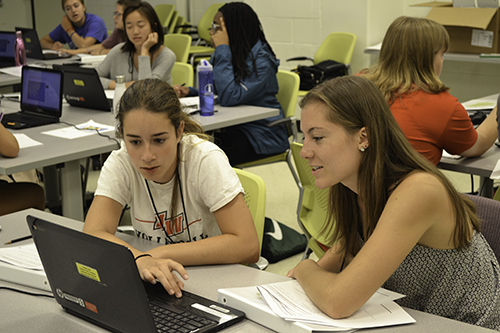
Two ESE GAMES campers collaborate on an activity.
From July 9–15, 20 environmentally-concerned high school students were on campus to participate in the Environmental and Sustainable Engineering (ESE) GAMES camp. In addition to learning about several key environmental and sustainability issues, campers also learned about career options available in the field— which according to several high school students, was why they participated in the camp.
Most of the camp's sessions were comprised of a mini lecture, followed by a hands-on activity related to the topic. Two addressed environmental issues: environmental footprints and climate change. Several dealt with renewable energy, such as solar, and wind and tidal. In one lesson, after learning about the air pollution produced by cookstoves, students made their own solar cooker. Several sessions also addressed water: water for energy, which included a trip to Abbott Power Plant, and some lessons about water purity, including a lab about water quality done at Boneyard Creek.
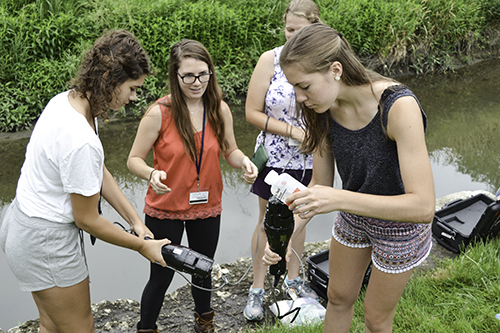
Campers test the quality of the water in Boneyard Creek.
New this summer was a field trip to the Urbana's waste water treatment plant...which compliments the camp’s water quality module. They also incorporated more hands-on data activities and, according to camp coordinator, Nicole Jackson, who admits to being “kind of biased towards my research," there’s more on water resources and agriculture.
Jackson acknowledges that “Every year we spruce it up…we tweak it a little. It is a function of who’s helping in a given year.” For instance, one of Tami Bond’s students taught a module on solar cookers. “So, they are going to make s’mores,” Jackson says.
Camp director Sotiria Koloutsou-Vakaki, in her sixth year running the camp, feels she and her grad student coordinators have hit upon a successful formula. “I think that we are succeeding at this, now, six years into the process, because [the students] seem to be very responsive, and they seem to enjoy it. At least, that’s what they let us know at the end of every lesson. We ask them to tell us how they felt; if they felt they learned something; they had fun. It’s a summer camp, right? So, they seem to enjoy it. So far, so good!”
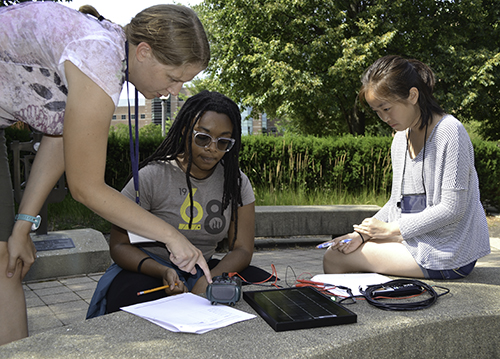
Mary Foltz works with two campers taking measurements using a solar cell.
Besides teaching about the environment and sustainability, she and her grad students also enjoy giving input to high schoolers grappling with future career choices. She says the camp gives “a very nice perspective for the students who are kind of stressed out as they start the application process for college, to take a step back and say, ‘It’s okay, I have many options...I have to think of what I like.’”
In fact, Koloutsou-Vakakis reports that during one session, the grad students shared their personal experiences regarding choosing their fields: “They said not everybody knows what they want to do the first day they apply to college, but that it’s something that develops. Of course, they emphasized the benefits of being an engineer, a problem solver, along with minoring in something else which gives the scientific perspective, because engineers build things for people. And for environmental engineers, that’s even more important.”
She also indicates that they've been seeing long-term results in terms of campers matriculating to Illinois: at least seven students have applied and been admitted, and from the last two camps, at least one student applied, was admitted, and is currently in Illinois’ Civil Engineering program.
According to Koloutsou-Vakakis, the main reason for GAMES camps is to “explain to other girls that STEM—whether it’s environmental engineering, civil engineering, mechanical engineering, or physics, or chemistry—it’s something that is interesting and something that they can do as well as everybody else. It can also be rewarding in terms of career and compensation.”
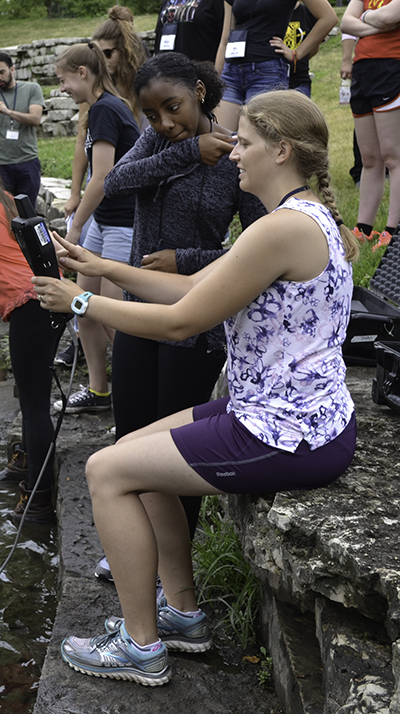
Mary Foltz (right) works with an ESE GAMES camper to analyze the results of water quality at Boneyard Creek.
Helping Koloutsou-Vakakis with the camp this year were around 8–10 Civil Engineering graduate students, including one of the coordinators, Mary Foltz, who just finished her Masters in Environmental Engineering and will be starting her Ph.D. in the fall. Helping with the camp for the second year in a row, Foltz got involved because she loves teaching. “I want to be a professor, so this is kind of the right fit for me. Teaching high school is what I did before I came to graduate school, and so this is really similar to that but a little different.” She also hopes to help the campers figure out what they want to do, and serve as a role model. Folz’s favorite activity of the camp? Water quality and water treatment (the one she helped teach, of course), which was done at the Boneyard Creek.
Regarding how many participants reported being interested in careers in environmental engineering, Foltz reports a mix: some were saying, “I want to be a civil engineer,” and took the camp because there’s no civil camp; some might want to do civil with maybe a concentration in environmental engineering. However, a number were environmentally focused and trying to decide between being an engineer or scientist, something Foltz could speak to. “That’s where I come in handy here," she says, "because my undergraduate degree was in environmental science, and now I am doing environmental engineering. So I have both aspects, and I can tell them what the differences are.”
“The girls here ask a lot of great questions," she adds, "and I love answering them and being honest and giving my perspective and being a good role model for them—showing them that there are women in engineering, and there are women in graduate school, and there are women doing everything that men can do.”
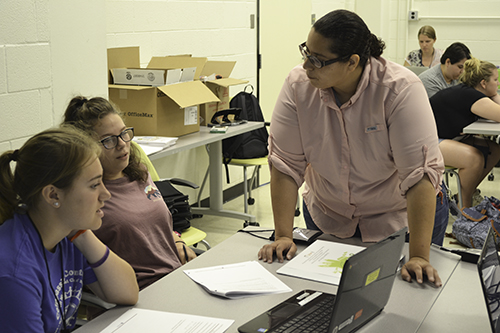
ESE GAMES camp coordinator, Nicole Jackson, helps two campers during one of the activities.
Alluding to the need to get more women in STEM, fellow Environmental Engineering Ph.D. student and camp coordinator, Nicole Jackson, refers to Civil Engineering's wall with pictures of endowed professors: “Well, I used to call it the wall of men.... all of the endowed professorships,” Jackson says. “But now, Dr. Bond (a woman) is a named professor. So now it’s a wall of men plus Dr. Bond.”
In her third year as a coordinator for the camp, Jackson shares why she does the camp every year:
“I’ve always been motivated to be an engineer. So, it’s kind of cool to see how young people decide that for themselves. So, the camp does a good job showing one facet of engineering and hopefully it sparks some, in general, to be interested in engineering, because I think it’s awesome. So every year is different. You never know who you are going to get at these things, which keeps it fun. I work with a great group of grad students too.”
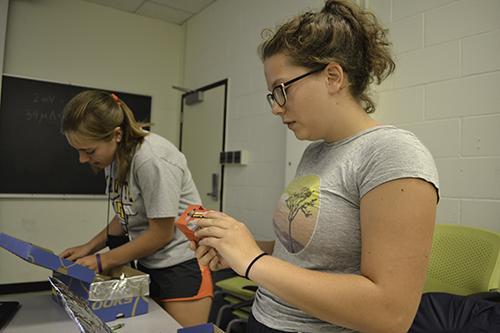
Two campers make solar ovens.
Does Jackson think any of the students might end up to be environmental engineers? “I think there are a few,” she says. “There are a few that are dead set on, ‘I want the planet to be a healthy place.’ I think, though, there are definitely some who are environmentally focused, but may not know how they want to do it in practice, which I think is totally fine and helpful. So, yeah, there’s a lot of eager minds amongst our 20 campers."
Koloutsou-Vakaki shares why she does the camp every year: “Well, it’s fun; it’s educational; it’s very rewarding to see these girls interacting.”
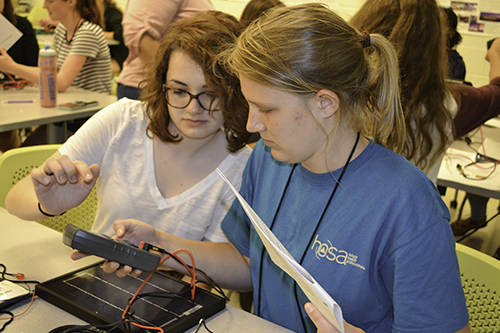
She says she also finds interacting with graduate students rewarding: “They are teaching; they’re preparing the materials; so they are very excited. They come with enthusiasm.”
She shares why the grad students appreciate interacting with the high schoolers. “As they prepare to go out and teach at the college level, most of them, they get to interact with students from different backgrounds and who have different motivations, different future plans.”
Koloutsou-Vakakis and company are not shy about acknowledging that their main purpose in doing the camp is to recruit more women to STEM: “That’s why we’re here! Ask all the questions you have; see what we are doing; we cannot show you everything, but we try to show some of the things that we’re doing. We are also trying to emphasize the science; we try to split between some hands-on and some theory.”

She reports that during camp, they were discussing the message that Microsoft sends regarding the shortage of women in STEM: “You turn on your laptop, and the moment you turn it on, under the Microsoft sign, it says ‘See, only 6.7% of women graduate with STEM degrees.’ So, this is not a Microsoft commercial, but I focus on the 6.7%, which is a very low number. So, I said to the student yesterday, ‘Well, what does that show? It shows a big opportunity, right, for more women in STEM.”
Like Koloutsou-Vakakis, Jackson also believes the camp is making headway toward increasing the number of women in STEM:
“I think it’s a really exciting time to be a woman in STEM. These programs are pivotal towards improving diversity. So, it’s great to be at Illinois and have a combination of a supportive college, which kind of provides the back-end to the program, and then a supportive department that allows students to donate their time, in a way, to promote the next generation of people.”
And several campers believed that they would end up in STEM, and maybe even environmental engineering.
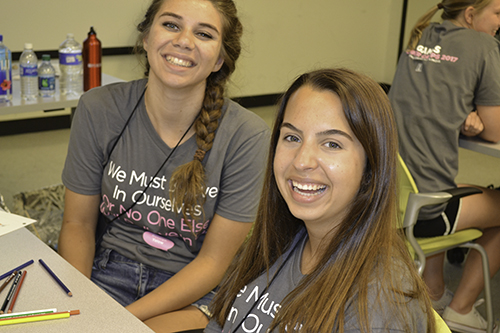
Nina Crawford and Paige Jenekowitz
For instance, Nina Crawford, a rising junior at Glenbard West High School, indicates that her purpose in participating GAMES was to check out the field as a potential career:
“I came to this camp because I heard about it from my ecology mentor, and I’m interested in being an environmental engineer. It’s kind of like a trial run for me to see if I like this and if I want to do it with my career.”
What does she think of the camp? “I like it a lot,” she admits. “I’ve met a lot of great people, and it’s really good to get experience in the field and getting experience in the math and trying different opportunities in the math and science field.”
She also believes she’ll end up in environmental engineering: “Yea, I think I’ll look at some of the career opportunities and majors that go along with engineering and environmental science.”
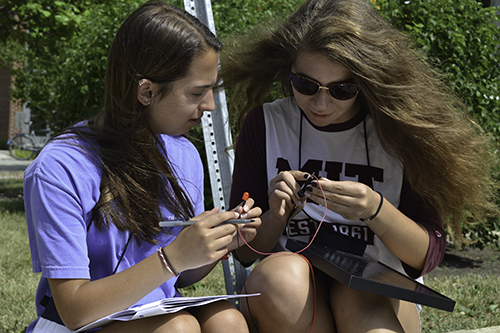
Paige Jenekowitz and Nina Crawford do an activity about solar cells.
Does she hope to end up at Illinois, too?
“Yes,” she affirms. “Both of my parents went here, and both my brothers go here.”
Like Nina, Paige Jenekowitz, a rising junior at Conestoga High in Pennsylvania, also participated in the camp to check out the field careerwise: “I came here because my environmental science teacher told me about it, and I wanted to be an engineer so she thought this would be a good idea to come here.
Paige reports that she was enjoying the camp: “I like it,” she admits. “It’s a really fun learning experience.”
Similar to Nina, she also thinks she’ll go into environmental engineering, and she’s interested in attending Illinois.
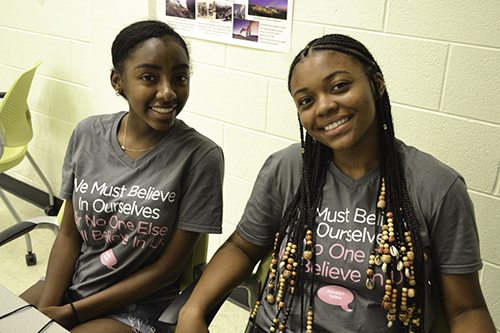
Cori Robinson and Chloe Walls
Like the other two girls, Cori Robinson, a rising senior, at Oak Park Forest High School in northern Illinois is also exploring her career options, and came to the camp after her mom told her about it.
“I’ve always been interested in engineering. I’ve never been sure of which type of engineering, so I thought it’d be a great experience to be exposed to some other aspects that I don’t usually see,” she says.
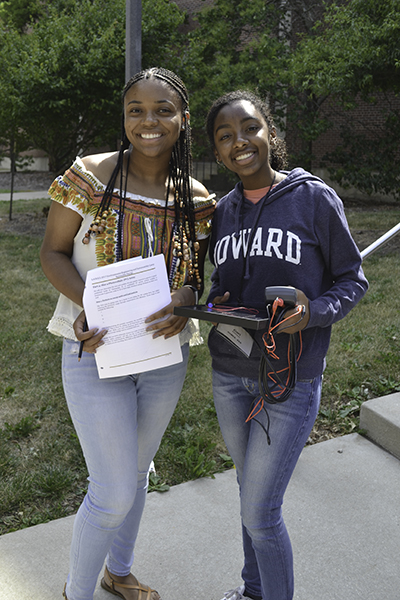
Chloe Walls and Cori Robinson take some measurements using a solar cell.
Robinson says she really enjoyed it. “It’s been fun. I enjoy a lot of the measurements when we go outside and have to take measurements, test things. I enjoy math a lot, so it’s fun.”
Robinson thinks she might do some type of environmental science and engineering. Does she you think she’ll come to Illinois? “Yes, that’s the goal,” she reports.
Chloe Walls, a junior at Homewood High School, shares why she came to the camp: “Because I took environmental science this year, and I really enjoyed it, and I also like physics and engineering, so I thought I should come to a camp and Illinois had one so I'm here.
While it’s the first GAMES camp you've been to, she believes it might have tipped the balance for environmental engineering: “It did,” she admits, “because I wanted to see if this was something that I like before I decided to major in it so I thought this would be a good way to try it out but I have enjoyed myself so far." Like some of the other campers, she says Illinois is her top choice right now.
Story by Elizabeth Innes, Communications Specialist, I-STEM Education Initiative.
More: 8-12 Outreach, Environmental Engineering, GAMES, GAMES: ESE, Summer Camp, Sustainability, Women in STEM, 2017
For additional I-STEM articles about G.A.M.E.S. camp, see:
- G.A.M.E.S. Campers Passionate about Saving the Planet Learn About Environmental Engineering (2016)
- Environmental Engineering G.A.M.E.S. Encourages Girls to Think/Design Green (2013)
- Campers Build Model Aircraft, Explore Possible Careers During Aerospace GAMES (2017)
- AERO G.A.M.E.S Campers Soar with New Aerospace Knowledge (2016)
- At G-BAM GAMES Camp Girls Learn They Can Make a Difference Via Engineering (2016)
- High School Girls Discover Chemical & Biomolecular Engineering at GAMES Camp (2016)
- Girls Experience Electrical Engineering First-Hand at the 2016 GLEE GAMES Camp (2016)













.jpg)
















